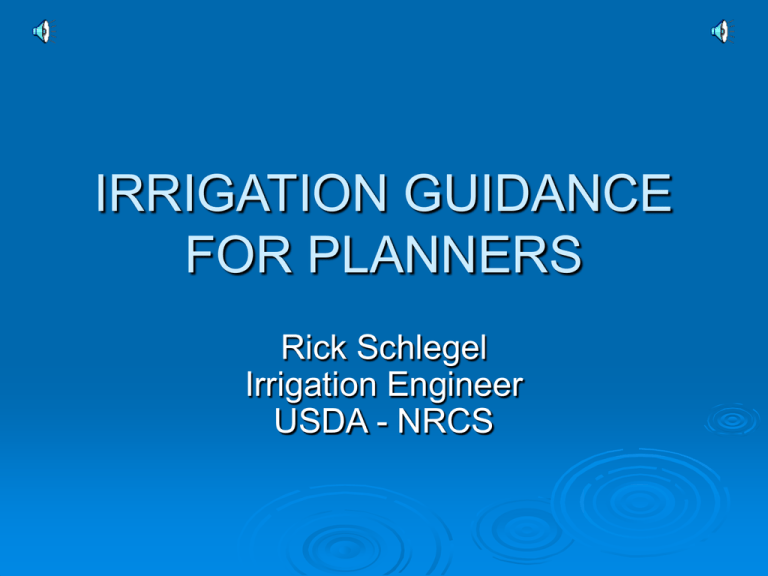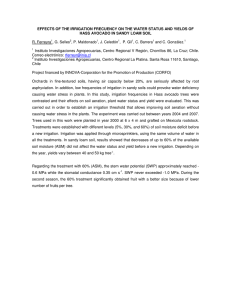Irrigation Planning in Oklahoma
advertisement

IRRIGATION GUIDANCE FOR PLANNERS Rick Schlegel Irrigation Engineer USDA - NRCS FIRST STEP - DO AN IRRIGATION SYSTEM INVENTORY System capacity or flow available Conveyance system & condition Irrigation system types Crops to be irrigated Predominate soil types being irrigated Irrigation water management being practiced by producer AFTER COMPLETING INVENTORY After the inventory is done, decide if the existing system is adequate or if the irrigator needs to: Install a new irrigation system Install flowmeters or chemigation valves Install a new pipeline or delivery system Change his cropping system to be more efficient Manage or schedule irrigation applications Decommission inadequate wells Let’s break down the inventory and talk about each item SYSTEM CAPACITY Needs to be large enough to meet crop water needs in a timely manner RULE OF THUMB FOR PLANNERS: High water use crops such as corn or peanuts - 7.0 gpm/acre needed Medium water use crops such as cotton, milo, soybeans – 5.0 gpm/acre needed Minimum to meet standard – 3.0 gpm/acre PUMP CURVES Conveyance System Generally use underground PVC Replace leaky or undersized lines RULE OF THUMB FOR PLANNERS: Below 400 gpm – 6” PVC 400 – 750 gpm – 8” PVC 750 – 1200 gpm – 10” PVC 1200 – 1700 gpm – 12” PVC Plan High Pressure Line when delivery system is long length or large elevation increases are encountered COMMON IRRIGATION SYSTEMS UNDER EQIP LEPA – Low Energy Precision Application LESA – Low Elevation Spray Application LPIC – Low Pressure In Canopy MESA – Mid Elevation Spray Application Drip System or Microirrigation LEPA SYSTEM LEPA SYSTEM LESA SYSTEM LPIC SYSTEM MESA MESA SYSTEM CROPS AND SOILS Determine crops to be irrigated Determine predominate soils to be irrigated Use Oklahoma Irrigation Guide to gather information for IWM plan Teach producer how to do Irrigation Scheduling UNDERSTANDING SOIL – WATER – PLANT RELATIONSHIPS TYPICAL CROP ROOT ZONE R A I N F A L L I R R I G A T I O N E V A P O R A T I O N ET EVAPOTRANSPIRATION DEEP PERCOLATION T R A N S P I R A T I O N AVAILABLE WATER CAPACITY (AWC) THE ROOT ZONE CAN ONLY HOLD SO MUCH WATER ( FIELD CAPACITY ). THE REST IS LOST TO DEEP PERCOLATION. “AWC” IS THE AMOUNT OF WATER HELD IN THE ROOT ZONE OF THE CROP THAT IS AVAILABLE TO THE CROP. AVAILABLE WATER CAPACITY A W C CLAY, CLAY LOAM & SILTY CLAY LOAM 2.0 IN/FOOT SANDY CLAY LOAM, LOAM, & SILT LOAM 1.8 IN/FOOT SANDY LOAM & FINE SANDY LOAM 1.5 IN/FOOT FINE SAND AND LOAMY FINE SAND 0.9 IN/FOOT MANAGING THE AVAILABLE WATER Using Management Allowable Depletion MAD MAD WATER BALANCE A W C M A D S T I N G Y TWO METHODS PLANNED 1. Manage the available moisture at 50% AWC 2. Manage the available moisture to let it drop to the level of a typical producer irrigation plus leaving a one to two inch depletion for rainfall. (1.5” + 1.0” = 2.5”) “MAD” EXAMPLES AT 50% CROP WITH FOUR FOOT ROOT ZONE: CLAY, CLAY LOAM, OR SILTY CLAY LOAM AWC = 8.0” MAD WB= 4.0” SANDY CLAY LOAM, LOAM, OR SILT LOAM AWC = 7.2” MAD WB= 3.6” SANDY LOAM OR FINE SANDY LOAM AWC = 6.0” MAD WB= 3.0” FINE SAND OR LOAMY FINE SAND AWC = 3.6” MAD WB= 1.8” AVAILABLE WATER CAPACITY CAN ALSO BE LIMITED BY: AWC PLOW PAN DEVELOPING AN IRRIGATION WATER MANAGEMENT PLAN SCHEDULING IRRIGATION USING EVAPOTRANSPIRATION METHODS Evapotranspiration Methods Using the Atmometer Using the Agweather Site on the Mesonet EVAPOTRANSPIRATION USING THE OKLAHOMA MESONET USING MESONET “ET” DATA USING EXCEL SPREADSHEET EQIP Incentive Payment ($10/acre) Eight basic requirements: 1. Irrigation system meets standards 2. IWM plan is followed 3. Report flow twice during season 4. Install two rain guages and record rain 5. Determine daily ET to use in scheduler 6. Spot check soil moisture monthly 7. Record irrigation amounts and durations 8. Keep scheduler & records & submit to NRCS 9. USE SCHEDULER TO MAKE DECISIONS




